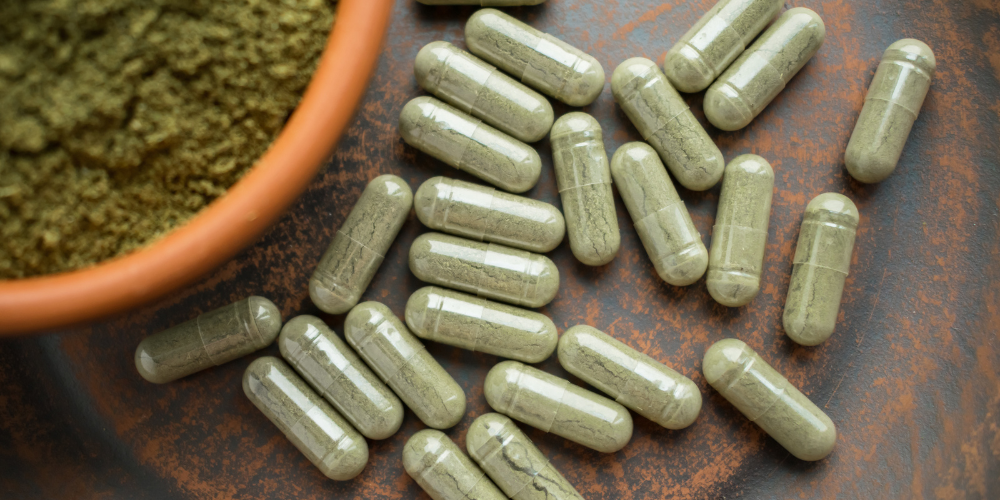(Updated: February 2025)
Kratom has recently gained popularity as a natural remedy for various ailments, including pain, anxiety, and energy enhancement. This plant, native to Southeast Asia, has a long history of use in traditional medicine. It’s now attracting global attention for its versatility and potential benefits. But what exactly is kratom, and how can it be used? Let’s explore its history, effects, and legal status, as well as how to use it effectively.

Short summary
Kratom is a natural plant from Southeast Asia known for its pain-relieving and energy-boosting properties. It is commonly used in powder, capsule, tea, or tincture form and can provide effects such as euphoria, relaxation, increased energy, and pain relief. Kratom's legal status varies by location, so it’s essential to check local regulations before use.
An explanation of kratom
Kratom is a tropical tree that thrives in Southeast Asia, particularly in countries like Thailand, Malaysia, and Indonesia. The plant’s scientific name is Mitragyna speciosa, and its leaves have been used for centuries as both a stimulant and a painkiller.
The leaves contain several alkaloids, which are responsible for their various effects. Kratom can be consumed in several forms, including powder, capsules, tea, and tinctures, and is known for its distinctive aroma and bitter taste.
A closer look at kratom leaves
The leaves of the kratom tree are about 45 centimeters long and 25 centimeters wide, with a smooth surface and a slightly hairy underside. They feature white veins and can appear dark green, red, or yellowish-brown.
The leaves’ unique texture and aroma make kratom a remarkable plant, and while the taste is initially bitter, many users find it becomes slightly sweet after chewing or when mixed with other substances, such as tea.
Leaves are processed in various ways, resulting in a variety of unique products. Here is a small selection:
How kratom is used
Kratom can be consumed in different ways, depending on user preference. Here’s a breakdown of the most common methods:
- Powder and capsules: Kratom powder is often consumed by mixing it with water, tea, or smoothies. If you prefer convenience, capsules are a great option. Typically, each capsule contains 1-2 grams of kratom powder, and the dose can be adjusted based on your needs.
- Tea: Making kratom tea is a traditional and popular method. To prepare it, add one tablespoon of fresh kratom leaves to a cup of boiling water. Let it steep for about 15 minutes before straining out the leaves.
- Tinctures: Kratom tinctures are concentrated extracts made from kratom leaves. They offer a more potent effect and should be used sparingly, especially by beginners.
History of kratom use
Kratom has a rich history in Southeast Asia, where it has been used for centuries for its stimulant and pain-relieving properties. Workers in the region would chew the leaves to combat fatigue and increase stamina.
It was also commonly used to treat pain, muscle relaxation, and even conditions like diarrhea. In modern times, many people have turned to kratom as an alternative remedy for addiction, anxiety, and depression, though scientific research into its effectiveness and safety is still limited.
Reported effects of kratom
Kratom’s effects can vary depending on the dosage and individual response. Some common effects reported by users include:
- Euphoria: Many users experience feelings of well-being and happiness.
- Relaxation: Kratom can have a calming effect, helping to alleviate stress and anxiety.
- Energy boost: In lower doses, kratom acts as a stimulant, providing an energy boost similar to caffeine.
- Pain relief: Kratom has analgesic properties, making it effective for treating chronic pain or inflammation.
While kratom can provide positive effects for many, it’s essential to note that the plant may not be effective for everyone. Some users report little to no effect, while others experience mild psychoactive effects.
Legal status of kratom
The legal status of kratom varies across the globe. In the United States, kratom is legal at the federal level, but individual states have different laws regulating its sale and use.
Thirty-five states have banned or restricted kratom in some form, while others have not yet made decisions on its legality.
Internationally, kratom is legal in most countries but faces restrictions in places like Malaysia, Vietnam, and parts of Europe, including France and Italy. However, in countries like Indonesia and Myanmar, there are exceptions that allow for the personal use of small quantities.
Kratom is an intriguing plant with a long history and a range of potential benefits, from pain relief to enhanced energy. While it is legal in many countries, its legal status can be uncertain in certain regions, so it’s important to be aware of local regulations before using it.
If you’re considering trying kratom, be sure to choose a reputable source that ensures sustainable and ethical practices, like Kratomit.eu, where you can find high-quality kratom products.
For anyone interested in exploring kratom's potential, it’s worth trying the various forms available, from powder to tea, and observing how it affects you.
Whether you're looking for natural pain relief, a mood boost, or an energy lift, kratom might be the plant you've been searching for.
Adela, Kratomit









